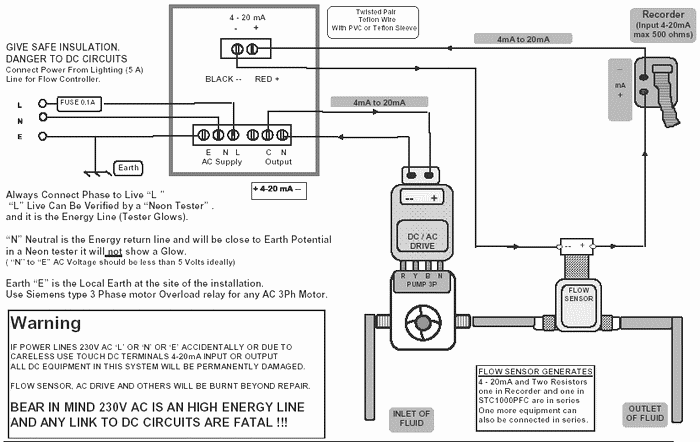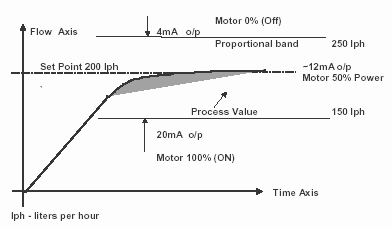Pressure and Flow Control Applications
Pressure Measurement and Control
Pressure is the next most important parameter after Temperature. In Hydraulics and Pneumatics, the measurement, indication, control and logging-charting of pressure is indispensable.
Popular Pressure Sensors are based on either Piezoresistive or Strain-Gauge Technologies. Strain-Gauge types can be Metal Foil or Semiconductor Film.
The Analog Strip Chart Recorder is used in Simple Systems
where a Record or Report has to be generated. Data Loggers
and PC based Data Acquisition Systems expand this capability
by making the Data Electronically Accessible for
Charting-Analysis and Reporting using database applications.
The Liquid-Fluid Level in containers of uniform cross-section can be computed by measuring the pressure of the fluid head. In cases where levels of semi-volatile fluids are measured, sensors with Micro-watts of power usage or data transmission is required to protect from sparking related accidents. Even Zener Barriers can help reduce risks due to wrong connections or cross connection due to cable damages.
In the field, due to various constrains many safety
practices can be overlooked or circumvented. The Sensors and
System design must be over-engineered in some cases to
safeguard man-machine assets.

Flow Measurement and Control
There are three Controls to be Adjusted to make a Proportional Flow Controller Perform Properly. This method has to be practiced and experience gained from it can be used to get very good and stable Control of the Flow or Velocity of a Fluid.1. Set Point. (SP)
This is the Flow Rate at which you require the Fluid to be controlled at. Adjust the rate at which the fluid flow is expected to be controlled .2. Process Value. (PV)
This is the Actual Flow Rate of the fluid in the flow sensor or its path. It is very important that the Flow Sensor is placed at a position in the fluid circuit in such a way to avoid cushions which may lead to oscillations around the Setpoint.3. Proportional Band or Dead band. (PB)
Dead band or H % or Hysterisis are terms used in on / off Controllers in proportional controller we use the term proportional band.4-20mA Control Signal
The Flow rate zone in which the Output is 4.1mA to 19.9mA which in turn Drives the AC-Drive >> Motor from 0% to 100% is the proportional Band. It is Given in % e.g. 50% PB of 200 lph SP is 100 lph. Band 150 lph - 250 lph
eg : The Motor is at 100% Drive ‘on’ till 150 lph and ‘off’ above 250 lph. ` Between 150 to 250 is the PB. A little above 150 the Motor reduces power gradually till at 250 it turns off. When SP=PV the output is 12mA (ideal)
here the motor runs at 50% of the total power.
Selection of Motor / Drive and circuit Capacity:
The Motor / Drive Combination must at 12mA Control signal give a flow Rate at which the system is used for most of the time this gives good stability. The max flow rate setting required by system must be achievable at 80% of Motor Time Axis Power this is to make allowance for load and line regulations. The Flow Circuit should have normal resistance to flow to reduce Oscillations.
STC1000PFC - P = Proportional Control, F = Flow, C = Current Output.

Tuning or Adjusting a Proportional Flow Controller
Step # 1
Ensure Flow Sensor Output 4-20mA is properly connected to the Flow Controller polarity reversal will show reducing reading in the Display as Flow rises. The Motor / Drive used and Power selected must be able to bring the Flow more than the maximum required Flow rate directly without control (open loop).So when in doubt connect motor/drive and run at max power and observe maximum flow rate e. g. if max. flow obtained with Motor at 100% Power (direct) is 300 lph the STC1000PFC can control flow rates upto 260 lph.
Step # 2
Keep PB in middle position and power on system e.g. set
Flow rate to 200 lph. Now Observe maximum overshoot. and
adjust proportional band as in table. (PB Control is a 300 lph
Single Turn Control with Ends.) SP 200 lph, PV (Process
Value).
After each change turn on system again to see response till 2 % or less variation or overshoot or oscillations are obtained.
| PV overshoot | Proportional Band |
| 10 % 220 lph or more |
Near Maximum fully clockwise till end. |
| 5 % 210 lph to 220lph |
Middle of the PB Control or towards max. |
| 2% 204 lph to 210 lph |
Little above present setting. |
| Less than 200 lph Droop e. g. 190 |
PB is Critically set Do not Change. |

Thumb Rule ! -
- Increment PB to Decrease Overshoot.
- Increment PB to Decrease Oscillations.
- Stop adjustment when PV droops around SP with no
oscillations.
- Adjust EC to match SP = PV after PV is stable at a point less than SP.
If proportional band setting is maximum, fully clockwise turn
till end (single turn pot) the motor will slowly ramp up to
full flow speed and ramp down slowly to reduce flow.
If proportional band is at the minimum, the motor will go full
speed till it comes close to the set flow rate and turn off
abruptly almost like an on / off controller the motor may
pulsate on & off near setpoint.
Step # 3
There is an additional control called Reset or Error Cal EC (
Integral) which is factory set for SP=PV 50% Power Output i.e.
Output Control = 12mA. In certain cases after stable reading
is obtained after adjusting or tuning PB the Flow may
stabilize say at 195 lph for a set point of 200 lph the
process is stable but a ten lphrees process error is present.
this can be Corrected with EC or RESET POT at the rear panel
(this is a endless 10 Turn Pot).
Digital weight Indicator - Load Cells
Adjust Error Cal provided in the back panel to increase Flow rate to 200 lph from 190 lph. when this is done give some time for system to respond after every 1/2 a turn 180 lph of the RESET (EC) control pot .
The RESET control is a Ten turn potentiometer like the SP
potentiometer after 10 turns the direction of turning must
change. Clockwise Increases Flow rate Anticlockwise decreases
Flow rate. (at min. PB setting EC pot sets the On / Off or
Operating Point).
Back to Process Control
Applications
...
...
...
...
...
delabs Technologies
30th Aug 2020
...
The documents, software, tools and links are provided to enhance the ability of an electronics student, hobbyist or professional by sharing information. The information, links etc. should be used by the website visitor, at his or her own risk and responsibility. There may be concept, design and link errors in the pages.
Creative Work, ideas and documents of delabs can be used for Product Design and Development by R&D Engineers, Hobbyists, Students and even firms for creating useful products. These cannot be used for reprint, replication or publishing online or offline.

